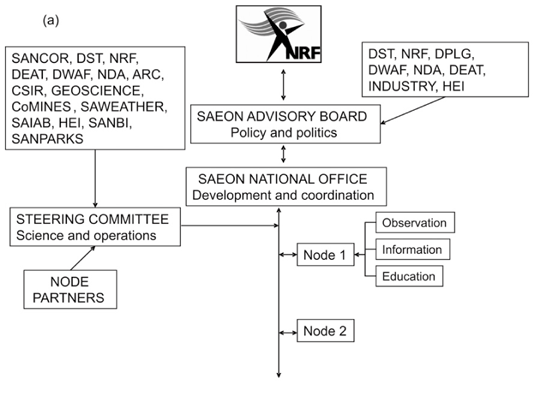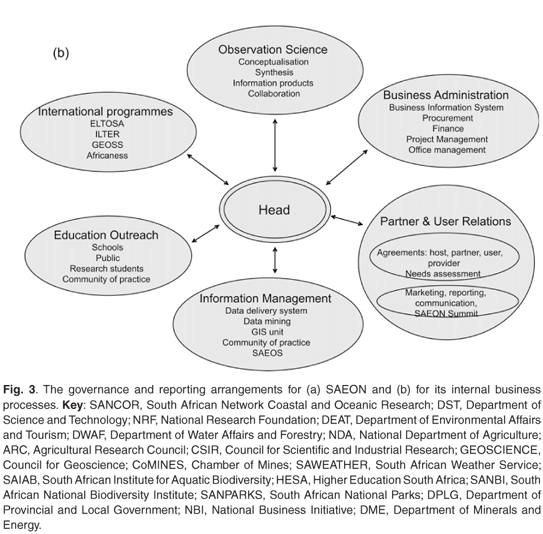Services on Demand
Article
Indicators
Related links
-
 Cited by Google
Cited by Google -
 Similars in Google
Similars in Google
Share
South African Journal of Science
On-line version ISSN 1996-7489
Print version ISSN 0038-2353
S. Afr. j. sci. vol.103 n.7-8 Pretoria Jul./Aug. 2007
SAEON REVIEWS
South African Environmental Observation Network: vision, design and status
Albert S. van JaarsveldI, ‡; Johan C. PauwII, ‡; Sarasvathi MundreeIII; Silvia MeceneroIV; Bernard W.T. CoetzeeV; Glynn F. AlardVI
ICentre for Invasion Biology, Department of Botany and Zoology, University of Stellenbosch, Private Bag X1, Matieland 7602. Present address: National Research Foundation, P.O. 2600, Pretoria 0001, South Africa
IISouth African Environmental Observation Network, P.O. Box 1758, Pretoria 0001, South Africa
IIICoastal and Marine Pollution, Council for Scientific and Industrial Research, Durban 4001
IVAvian Demography Unit, University of Cape Town, Rondebosch 7701
VCentre for Invasion Biology, Department of Zoology and Entomology, University of Pretoria, Pretoria 0002
VISavanna Ecosystem Research Unit, SANParks, Skukuza 1350
ABSTRACT
The South African Environmental Observation Network (SAEON), which has its origins in the scientific community, has evolved significantly over the last five years. Core government support for this emerging initiative became a reality in 2002, when the first funding commitment was made. The establishment of an ambitious distributed national environmental observation system requires extensive partnership arrangements, ranging from participating government departments, through numerous institutions and the corporate sector, to the active individual researchers. In its first three years, SAEON has established its credentials within the South African scientific community, created and staffed a national office at the National Research Foundation, launched the first three of six envisaged distributed observation nodes, expanded its regional and international relevance, and has made great strides with an educational outreach programme. Three additional nodes are nearing completion and all should be operational by early 2008. The financial and institutional sustainability of SAEON was of paramount importance and consumed most of its energy during this establishment phase. The current three-year period (2006–2008) is devoted primarily to securing the scientific sustainability of the SAEON initiative through its nodes and associated partner networks, and to integrating its various functions.
The origins of SAEON
The South African Environmental Observation Network (SAEON) has its origins in the ecological research community. At a national workshop held in Skukuza in 1999,1 this group of researchers articulated a need to formulate a national approach towards long-term ecological and environmental observation science. This led to an exploratory visit by South African scientists to the United States to view the workings of the Long-Term Ecological Research (LTER) system2 from the inside. A subsequent proposal was submitted, under the auspices of the National Research Foundation (NRF), to the then Department of Arts, Culture, Science and Technology (DACST) to support such a national initiative. This was followed by a period of intensive multi-party negotiations and discussions with potential stakeholders, both inside and outside of government, to create a workable model that addresses stakeholder needs and establishes the necessary science and institutional arrangements to meet national priorities in the field of environmental observation. In response to this proposal, DACST awarded the NRF a five-year grant of R21.8 million to establish SAEON, starting in 2002. As of 2008, the Department of Science and Technology (DST) will commit R15 million annually to SAEON. In this article we take stock of what has been achieved and what emergent challenges remain to be overcome at the end of the initial four-year grant period.
The SAEON vision and mission
Loosely defined, SAEON's initial objective was to establish a research platform for environmental observation. This platform was seen as a coordinated network of interconnected ecological and environmental observation sites that would collectively harness ongoing ecological observations, facilitate collaborative research and archive data to promote better and timely environmental management and governance. This collective environmental observation platform was seen simultaneously as an instrument for developing and raising awareness of environmental science among schoolgoers and jump-starting the careers of the next generation of young scientists.1 SAEON's core observation programme will strive to distinguish between anthropogenic and natural environmental change and to unravel the relations between social and ecosystem change.
SAEON's purpose and design have been refined since their initial conception in 1999. A shift from a purely ecological to a broader environmental focus to embrace human–environment interactions, emerged from the consultation rounds with government stakeholders, the corporate sector and members of its advisory board. Moreover, an even broader emphasis on Earth observation has recently come from within SAEON's Technical Steering Committee,3 in response to emergent international and national developments and agendas, all of which serve to make SAEON and its potential role more pertinent and responsive to the needs of civil society. SAEON is aligned to relevant aspects of the Science and Technology White Paper of 1995, the World Summit on Sustainable Development of 2002, South Africa's National Research and Development Strategy of 2002 and the Department of Science and Technology's 10-year plan of 2007. The most recent vision and mission statements, drafted in consultation with the science community, and accepted by the SAEON advisory board are outlined in the Box overleaf.
Partnerships
Although SAEON is being implemented by the NRF, the DST acts as the principal guardian of the initiative in terms of its mandate to provide critical science infrastructure for the country. Other government departments have also participated in SAEON's creation and continue to contribute to its development. These include the departments of Environmental Affairs and Tourism, Water Affairs and Forestry, Agriculture, Minerals and Energy, and Provincial and Local Government. Representation from the business sector at advisory board level has also been achieved and other government departments are viewed as strong potential partners in this venture (for example, the Department of Land Affairs).
| SAEON's vision and mission Vision A comprehensive, sustained, coordinated and responsive South African Earth observation network that delivers long-term reliable data for scientific research and informs decision-making for a knowledge society and improved quality of life. Mission The mission of SAEON is to facilitate the delivery of long-term Earth observation data* to users in accordance with their needs. It will achieve this through:
* SAEON's intention is to focus explicitly on the in situ observation and integration of ecological and environmental data relevant to changing ecosystems in South Africa. These data can be complemented by other types of data, including those obtained from space science platforms, for adequate understanding and decision making. |
In addition to this broad and more formal policy-level representation, the number of partners within the technical and science sphere is also rapidly expanding, during the establishment of the various observation nodes across the country, by virtue of their involvement with the Technical Steering Committee. These include the departments of Agriculture, Water Affairs and Forestry, Environmental Affairs and Tourism, and of Education, the South African Data Centre for Oceanography, the Agricultural Research Council, the Council for Scientific and Industrial Research, the Council for Geoscience, Mintek, the Chamber of Mines, the South African Weather Service, the Water Research Commission, the South African Institute for Aquatic Biodiversity, the South African National Biodiversity Institute, South African National Parks, CapeNature, Ezemvelo KZN Wildlife, and various universities.
The essentially consultative nature of SAEON meant that a large number of stakeholders had to be involved in creating each node. This was the primary constraint in establishing SAEON hitherto. A quicker approach may have been feasible, but it would have failed to achieve the necessary degree of support and hence its present sustainability.
International linkages
SAEON's focus on long-term monitoring gives it a natural home in the International Long-Term Research Network (ILTER). The NRF hosted an ILTER meeting in 1999 and this was followed by a successful application for membership by SAEON in 2002. Since then, SAEON has participated in ILTER meetings and is currently serving as the African representative on the ILTER Executive Committee.
SAEON was also a founding member of the Environmental Long-Term Observatories of Southern Africa (ELTOSA), a regional network of ILTER.4,5 Here also SAEON played a leading role in its strategic development, organization and fund raising, and is currently serving as the chair and hosting the ELTOSA website. SAEON's African networking has included the recently established ICSU Regional Office for Africa as a contribution to its NEPAD vision.
A recent development is that of the intergovernmental Group on Earth Observation (GEO), which was established in 2003 and has since developed the concept of a Global Earth Observation System of Systems (GEOSS). The DST has played a leading role in these developments and has subsequently prepared a South African Earth Observation Strategy (SAEOS) that aims to create the electronic linkage between relevant South African Earth Observation data holdings and GEOSS (see Fig. 1). GEOSS represents the political and policy dimensions of Earth observation and will facilitate the implementation of appropriate global responses emanating from the Earth observation system. It is envisaged that SAEON will be a critical intermediary in the proposed SAEOS electronic linkage with the GEOSS process. The network will provide important ecological, environmental and Earth observation confirmation of information gained from other sources such as satellite images.
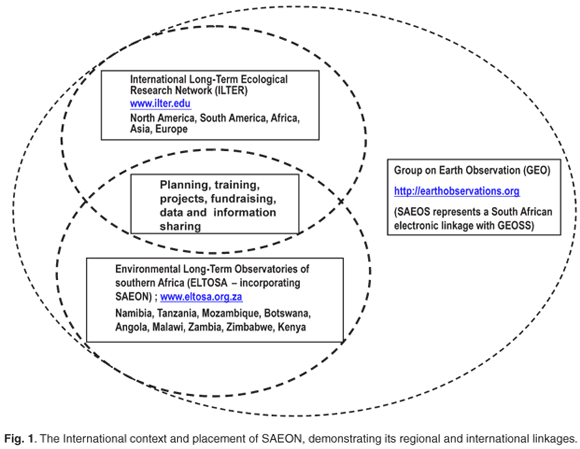
SAEON design and implementation
Observational design. The design template used to implement SAEON was derived by simultaneously considering the distributions of the primary catchments, the biomes as well as the eco-regions of the country.3 These were assimilated into a number of observation regions with the intention of establishing a distributed node in each of these broad observation regions (see Fig. 2).
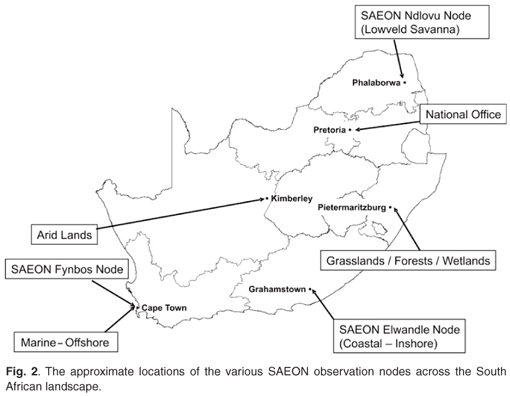
The observational approach is based on models of ecosystem driver and response variables and appropriate observation systems that will elucidate the relationships among them. The design of such observation systems may be based on an array of multiple-scale sites, ranging from intensively monitored core sites to remote sensing, or it may require consideration of whole ecosystems. Transects will be set across contrasting environmental gradients as a form of 'natural experiments', in particular to study the impacts of climate change on biodiversity and hydrology. The approach relies heavily on the contributions from partnering organizations and is supplemented by the archiving and analyses of historical data sets.
Information management system. The SAEON information management network is designed to receive and archive the observational data emanating from its observation network for use by the South African environmental research community, environmental policy makers and managers. This information backbone, which will link all nodes and the national office in Pretoria as well as the international Earth observation systems, has reached its second phase of development and should be operational by mid-2008. A joint project with the CSIR has developed a geo-spatial portal running on open source software with innovative technology that overcomes some of the local bandwidth problems. This will form the heart of the information system and will allow for interoperability among the different data holdings of SAEON participants, and for producing analytical and synthetic products. A SAEON postdoctoral project to establish a directory of metadata of long-term data sets will be one of the first projects to be made available via the geo-spatial portal. This project has taken the lead in setting standards for ecological metadata and has benefited from collaboration with the US National Centre for Ecological Analysis and Synthesis (NCEAS).
Institutional design. SAEON's reporting relationships are illustrated in Fig. 3. The advisory board oversees SAEON at a policy level, whereas the Technical Steering Committee advises on scientific and operational directions. Node matters are deliberated by a liaison committee in each case. The multi-stakeholder design of SAEON has proved to be a key strength, ensuring high quality and resilience in decision making. The downside of these interactions is the considerable burden they place on time and finances.
Progress with observation platforms
SAEON Ndlovu Node (Savanna). This first node, created to service the Savanna Biome, was officially launched in September 2004 at Phalaborwa. It was developed following consultative meetings with the Kruger National Park, the University of the Witwatersrand and the Agricultural Research Council concerning various node-specific issues, for instance, the location of the office, monitoring of elephant impact, and priorities for spatial analysis. Offices and a sizeable laboratory have been constructed. A GIS and data manager has been recruited and a considerable amount of data has been received from the private and public sector, which is to be made accessible and analysed for environmental trends. The education outreach programme has already completed projects through the efforts of a dedicated staff member.
SAEON Elwandle Node (Coastal-Inshore). The hosting of this node was assigned to the South African Aquatic Biodiversity Institute (SAIAB) in Grahamstown. This decision was preceded by several consultative workshops, a comprehensive analytical report and on-site assessment of the potential node hosts. The node services the coastal-inshore zone, inclusive of the estuaries, in collaboration with other parties such as the National Ports Authority, SANParks, Marine and Coastal Management, the Oceanographic Research Institute, the South African Network for Coastal and Oceanographic Research, and the Water Research Commission. The node has appointed its full staff complement and student researchers. Some monitoring and baseline projects have already begun.
SAEON Egagasini Node (Marine-Offshore). The Marine and Coastal Management Branch of the Department of Environmental Affairs and Tourism serves as host. A strong affiliation with the Southern African Data Centre for Oceanography (SADCO) was secured after obtaining responsibility within the NRF for managing the multi-sponsor SADCO project. This in turn is serviced technically by the CSIR.
SAEON Fynbos Node. The Kirstenbosch Research Centre of SANBI has been designated as the host. A manager has been recruited and the node will become operational in January 2008
The Arid Lands. This node will be hosted by SANParks in Kimberley and will become operational later this year.
The Grasslands/Forests/Wetlands. This node will be hosted by Ezemvelo KwaZulu-Natal Wildlife in Pietermaritzburg and will function in association with the University of KwaZulu-Natal.
SAEON Summit. The first of these four-yearly events for the deliberation of observation science, information management and education outreach issues helped to extend the support for SAEON and advanced its conceptual development (www.saeon.ac.za/2006/ a-successful-foward-looking-trendsettingsummit).
Observation science specialist. The position of observation science specialist was created to lead the core observation programme performed by all the nodes, to produce immediate products based on existing data, and to ensure the delivery of appropriate information for science and policymaking.
Manager: Stakeholder Relations. This new position will promote communication and facilitate interactions and relations with SAEON's partner. The post links to long-term strategies in government departments, science councils, higher education and relevant industry, with a view to releasing resources and exploring and establishing new opportunities for collaboration.
The roll-out of SAEON
A comprehensive time-line for the development of SAEON is presented in Fig. 4, which outlines the processes that were followed, the timing of particular initiatives and where the maturing of SAEON presently stands. This figure indicates the broad consultative process that has involved regular liason with stakeholders.
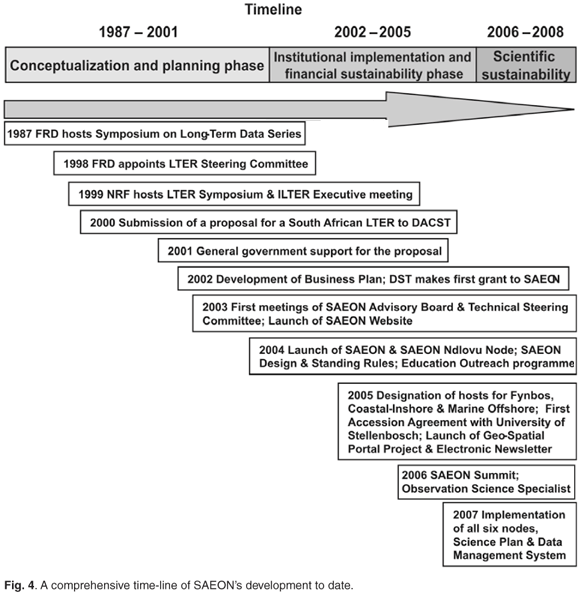
The time taken to establish SAEON has been one of the main criticisms levelled against it. However, the complexity of establishing a collaborative venture with government departments, the private sector as well as the science community for each node is daunting. Despite these difficulties, the persistent belief in doing science better collectively lies at the heart of the evolving SAEON initiative.
Financial futures
SAEON is currently funded through a three-year rolling grant from the DST managed by the National Research Foundation. Expanding the funding base is a fundamental challenge to the new organization. These efforts will focus on national and international collaborations, the sponsorship of education outreach programmes and exploring which types of corporate services can be provided by SAEON to user communities. This last activity could be used to both increase the funds available and supplement the core staff. From Fig. 5 it is clear that DST's projectedcontribution of R15 million core funding per year as of April 2008 will place SAEON on a more financially secure basis. Contributions in kind have already been leveraged by SAEON from the stakeholder community, and it is believed that contributions from NRF programmes will gradually rise in accordance with the demand for funds from associated researchers.
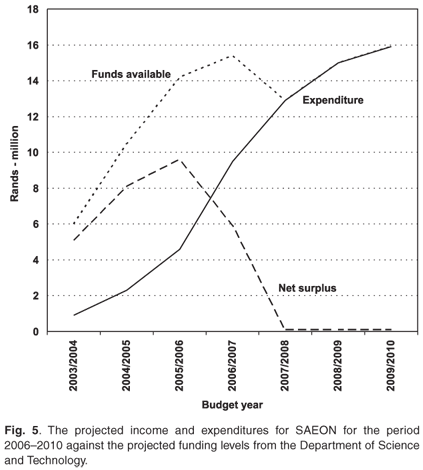
SAEON and capacity development
Education outreach programme. The education outreach programme has taken off at the SAEON Ndlovu Node. It is proving to be a successful community intervention by contributing to science education and awareness in a rural setting with several poorly resourced schools.6 Various activities have been completed. These range from a National Science Week and Women's Day programmes, which were attended by thousands of pupils, to discussion forums and training sessions for science teachers.
An innovation that will see schoolgoers involved with handson environmental monitoring projects around Phalaborwa has been met with enthusiasm and will serve as a vehicle for science and mathematics education, and should stimulate the pursuit of careers in science. More generally, this programme has attracted a significant number of partner organizations, and has managed to spread its contribution to social development across a spectrum of schools and communities in its vicinity.
Graduate Student Network. SAEON launched its Graduate Student Network in 2006 in response to a call from graduates.6 This movement, with a membership of over 100, was born out of an ambassadorial visit by South African graduates to the First International LTER Graduate Student Collaborative Research Symposium in Oregon, U.S.A., in April 2005. Here, graduate students from 34 different LTER sites across the globe shared their research interests and received research training. Formally launched during the inaugural SAEON Summit, the Graduate Student Network has since held two national workshops. Both occasions aimed to promote interaction among graduate students, and between students and senior scientists, within the realm of long-term ecological observation science. The first workshop, held directly after the summit, was attended by 37 students and five invited speakers. Twenty-seven scientific posters were also presented, which testifies to the growing interest in ecological observations in South Africa. The second workshop was held at Skukuza, Kruger National Park, and showcased SAEON's Ndlovu Node. Students, including the co-chairperson of the US-LTER Graduate Students Network, presented their research, and invited speakers led field trips and training sessions. The students have also launched their own website at www.saeon.ac.za/students. The network is organized and monitored by a national student committee. The first national symposium was held in Cape Town in September 2007, with a focus on SAEON's Marine and Fynbos nodes.
Science careers in observation science. A principal objective of SAEON is to provide a growing number of employment opportunities for a new generation of scientists in the broad area of observation science. At this early stage, SAEON already provides science-related careers to seven people, and the planned roll-out allows for more than 20 scientists to be employed by SAEON by 2009. By continually expanding these opportunities as the SAEON network unfolds, it can significantly contribute to increasing science capacity in South Africa.
Critical factors for the success of a national facility for observation science
The pursuit of a national facility for long-term environmental monitoring and Earth observation requires a new way of conducting ecological science in South Africa and, more generally, also in managing an integrated network of scientific institutions and activities.
Long-term monitoring is typically the responsibility of the state, whereas universities and science agencies engage in projects of limited time and spatial scales aimed at predetermined end products. This is as much a result of constantly changing funding regimes and limited capacity as it is driven by the need to produce graduates. The SAEON approach to ecological observation requires a nationally coordinated, long-term and multi-scale approach, with scope for many researchers from a range of disciplines working on a number of distributed sites to participate voluntarily in the programme for as long as they see fit.7 The SAEON network design is revolutionary and requires a cultural shift in ecological research.
A critical aspect is to ensure that the data generated are archived and accessible for successive research projects. For this to happen, a culture of data sharing, already slowly growing, is a prerequisite. The information technology and Internet developments of the past two decades not only make it possible to archive and analyse large quantities of data but have also stimulated an information-sharing culture. The pressure on ecological science to integrate socio-economic directions as well as to deliver meaningful products for policy makers and environmental managers is increasing and is a core deliverable of the SAEON approach.
SAEON is a network of organizations, people, sites and shared observational infrastructure. It is not a physical institute and relies on voluntary participation within a broad conceptual design. This requires inter-organizational sharing of resources and infrastructure and therefore a healthy measure of interinstitutional openness. This can be achieved only if SAEON itself maintains permeable boundaries and a neutral position in the politics of science. The network and its participants will have to demonstrate maturity and political will to cooperate freely and effectively. Initially, much effort goes into legalizing cooperative efforts by the drafting of memoranda of understanding and agreement that will facilitate and regulate those efforts. This is time-consuming but should eventually institutionalize the way cooperation is effected for mutual benefit, as SAEON matures as a virtual institute or facility.
Important lessons learnt
One of the primary lessons learnt is that core sites and a core observation programme are remarkably complex concepts, as is also the development of a large-scale ecological network.7 These concepts lead inevitably to long but indecisive debates. With hindsight, this was to be expected given the long-term nature of financial and scientific investment that a core site and a core observation programme require and the multitude of people to be satisfied. SAEON requires large-scale integration of historical, ongoing and new observation programmes managed by individual organizations and researchers. Ready-made answers are not forthcoming and in-depth consultative processes are needed.
Another lesson learnt is that a network organization requires substantial communication programmes to promote cohesion and coordination among nodes and their participants, as well as to inform the users and stakeholders of progress and developments. The normal internal communication channels of a research institute are not available to a networked organization. Consequently, electronic communication through a newsletter and a regularly updated web-portal linking to the different network organs are critical components of the operation.
SAEON's international connectivity and outreach into Africa has borne much fruit, both in terms of learning opportunities, benchmarking, accessing resources and services, and influencing international platforms to achieve national objectives. The management of SAEON's international relations should increasingly be regarded as a full-time portfolio due to the high cost in time and finances that it requires (see Fig. 3b).
Into the near-future
With its foundations laid, its credibility confirmed and steady progress in growing its business, SAEON has embarked on a three-year phase (2006–2008) that will be devoted primarily to establishing the scientific and financial sustainability of the initiative through its nodes and participants, and to integrating its functions. The observation science specialist will play a key role in coordinating the core science programme and in producing critical and enabling information tools. This will be facilitated by the data management system and by SAEOS. Given the variability of ecosystems over time and space, the ultimate challenge will be to design the core science programme for adequate statistical power.7 For further information about the SAEON initiative, please consult the SAEON website (www.saeon.ac.za)
1. van Jaarsveld A.S. and Biggs H.C. (2000). Broad participation enhances initial steps towards a South African ecosystem observatory system (LTER). S. Afr. J. Sci. 96, 63–66. [ Links ]
2. Biggs H.C., Kerley G.I.H. and Tshiguvho T. (1999). A South African long-term ecological research network: a first for Africa? S. Afr. J. Sci. 95, 244–246. [ Links ]
3. Anon. (2004). The design of SAEON. Online: www.saeon.ac.za/documents/ general/design_2004.pdf/view [ Links ]
4. Henschel J.R. and Pauw J.C. (2002). Environmental observatories: LTER à la Africa. In Rebirth of Science in Africa, eds H. Baijnath and Y. Singh. Umdaus Press, Johannesburg. [ Links ]
5. Henschel J., Pauw J., Banyikwa F. Brito R., Chabwela H., Palmer T., Ringrose S., Santos L. Sitoe A. and van Jaarsveld A. (2003). Developing the Environmental Long-Term Observatories Network of Southern Africa (ELTOSA). S. Afr. J. Sci. 99, 100–108. [ Links ]
6. Anon. (2006). South African Environmental Observation Network: Overview April 2004–March 2006. SAEON, Pretoria. [ Links ]
7. Andelman S.J. and Willig M.R. (2004). Networks by design: a revolution in ecology. Science 305, 1565–1567. [ Links ]
‡ Authors for correspondence. E-mails: albert@nrf.ac.za; johan@saeon.ac.za













